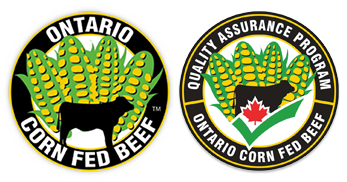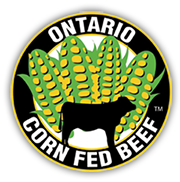Welcome everyone to the latest edition of The News Feed Live Webinar #6
- Once again, this webinar was produced in collaboration between OMAFA and Ontario Corn Fed Beef Program
I want to acknowledge the following people that contributed their time and effort into producing this evenings Webinar.
To begin with, I am pleased to acknowledge and thank Megan Van Schaik, OMAFA Beef Specialist, who was actively involved in the planning and capturing of footage and narrative of this webinars content… she is currently on maternity leave with her family.
- Christoph Wand, Livestock Sustainability Specialist, OMAFA and James Byrne, Beef Cattle Specialist, OMAFA and Chad Mader, Beef Cattle Specialist, OMAFA are in the background looking after technical duties.
- Ontario Corn Fed Beef Producers, Sarah Alton of Ken Ruth Farms, Lucknow and Stephen Dippel of Dippel Farms, Ayton discussed their operations and we certainly appreciate them taking the time to do so along with the narration of the videos we have of their feedlot facilities. Great to have producer participation …certainly adds another dynamic and quality to the webinar.
- Mac Littlejohn, partner with the Kirkton Vet Clinic will discuss his findings as a dairy and beef veterinarian within his practice. Mac will also discuss the importance of preventative medicine protocols including facility designs, ventilation systems to improve the cattle environment.
- Our OMAFA presenters, Dr. Jeff Thomason, Ontario Veterinary College and Dr. Tom Wright, Dairy Cattle Specialist | ADB, for their part in demonstrating/outlining the research data that is being conducted with the dairy herd at the U of G research facilities in Elora. There is a close connection with beef and dairy feet and leg issues, so we thought it was very pertinent to show the research being conducted at Elora and their findings.
- Cynthia Miltenburg, Lead Veterinarian Animal Health and Welfare, OMAFA, is our host / moderator for this webinar and will formally introduce each participant throughout the evening.
Note – I personally took part in the initial stages of planning this webinar, with a keen interest in tonight’s topic, however all the grunt work has been carried by the aforementioned people in my recent absence and I’m very grateful for that.
Webinar #6, in my opinion, is segregated into very specific areas of management conducted by the producers on their farm operations.
This webinar strives to point out the management level required of the producer to successfully take a new group of cattle and bring them on feed and advance them through the starter phase, grower phase and into the finishing phase.
Leg and feet issues can be related back to the cattle, but more often than not, proper management of the variables in the feedlot are responsible for, at the very least some of the issues. These could include, air quality, feed intakes, rumen/gut health, maintaining ideal Ph levels throughout the digestive tract, respiratory health, cattle comfort and access to lots of fresh clean water.
Key Points Supported in Webinar #6
- Bunk Management – start-up/ step-up ration’s – number of rations used to safely bring cattle on feed as safely and efficiently as possible.
- Ontario’s beef production by and large is made up of “Farmer Feeders” who grow crops and feed cattle …requiring management and time commitments that overlap significantly at times.
– remember cattle performance dictates profitability year-round on your operation – turning those crops into pounds of beef.
– cropping duties during planting and harvesting seasons need to adapt to constant/consistent cattle caretaking duties…. cattle are 1st – they pay the bills!!
- Health Risk Assessment needs to be assigned to each incoming group of cattle as – High, Medium and Low with defined protocols applied to each category and followed diligently
- Bunk Management – Consistent bunk scoring on daily basis – adjusting for any consumption changes – small increments at a time -stalled and gorging cattle create digestive upsets which lead to other related health problems
- Density of pens and adequate bedding – cattle comfort is golden
– cost of extra bedding is minimal compared to usage of antimicrobials and lost cattle performance!!
- Type of floor – slats – rubber matting – migrating bedding pack – scrape and bed – pack buildup – all reflect on specialized management and cattle peak performance
- Ration composition – DM / Moisture content relates to DM intakes which need to be consistent – moisture improves intake
- Feed Ingredients – proteins and energy sources – balance those levels – seek nutritionists’ input
- Feed Additives – a number of management/performance enhancers available to better cattle performance -research them – conduct trials – determine values
- Foot bath tools and applications, including very practical units to high throughput units…. all with a functional purpose
- Management of pull cattle – when to pull protocol– treatment protocols, using treatments 1,2 or 3 – recovery pen – return to home pen protocol – must have veterinarian involved
- Cattle high traffic areas constructed/designed to eliminate possible injury to the cattle – especially processing and sorting areas
Dairy
We are pleased to have our dairy producer friends taking part in tonight’s webinar as well
Dairy producers have a greater opportunity to manage their herd in that the cattle walk alleys to be milked 2 to 3 times per day …. easily accessing foot/ hoof treatments.
– Draw backs are wet slippery floors…more injury prone due to longer life span within that environment.
Summary
As more data becomes readily available, it becomes more demanding of our time, which is being constrained at times.
Production management and business management skills are essential in agriculture today and by surrounding yourself with the best of, passionate, experienced, knowledgeable people within the industry will enhance your position on your farm. Having those people involved will give you confidence in making those management decisions within your operation.
“Great teams push you to grow- both personally and in business!
I look forward to this evening’s discussions on these interesting topics as it reflects on cattle performance much more than we realize.
Enjoy the webinar!
In summary for this evenings Webinar #6.
I certainly appreciate the presenters and producers for the video’s description and the technical presentations as well.
The discussion period was very engaging and informative…I always enjoy this format and thank you very much to our registrants for joining tonight and participating in those discussions.
Our next webinar will be on the Benchmarking project …planning to be held in March of 2025.
Watch for details

